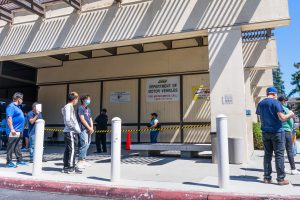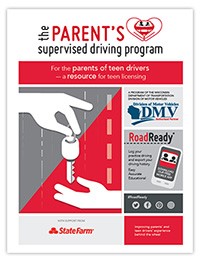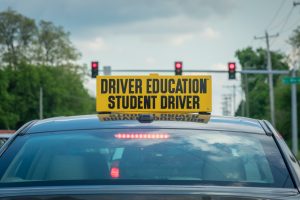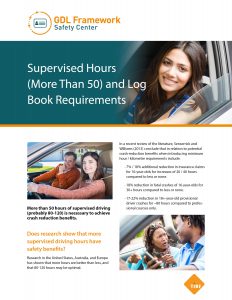When new drivers are ready to get on the road, but a pandemic has pressed pause on learning to drive
One of the most widely anticipated rights of passage for young adults is getting a driver’s licence. It symbolizes the transition from a young person to a young adult and brings with it an irreplaceable sense of accomplishment and independence. But what happens when a global pandemic interrupts the delivery of driver training in the classroom and on the road, and road tests are suspended?
This is a tough time for all those teens who are looking forward to getting their licence, and parents who are anticipating fewer parent-taxi requests. We understand the disappointment shared jointly by you and your teen. You have worked hard to fulfill the hours of practice, coaching, supervising and driver training to prepare teens for the road and ensure they comply with graduated driver licencing (GDL) requirements.
Governments and licensing authorities across North America are working equally hard to find alternatives to facilitate the safe reinstatement of licensing services during this challenging time. As they explore alternatives to help teens get safely on the road, there are some steps parents can take to reinforce safe driving habits of teens and prepare them for the reinstatement of driver training programs and road tests.
Impacts of COVID-19 on driver education and licence testing

Moreover, road test appointments are suspended indefinitely at many driver licensing offices. This is because safe alternatives to address this issue are, frankly, in short supply. To reduce backlog and maintain a contactless approach, the Georgia Governor initially issued an executive order for road test waivers. They subsequently updated it to allow any 16-year-old with a learner’s permit to get a state driver’s licence after passing a modified road test on a private property road course with a parent in the vehicle and the driver examiner giving instructions and monitoring the test drive from outside of the vehicle. While a strategy primarily designed to reduce the backlog of teens waiting to take the road test to get a provisional driver license may appear to have some intuitive appeal in principle, it raises concerns with road safety stakeholders, like me. Research shows teen drivers have a crash risk 2 to 3 times the risk of drivers 20 years and older, and persons most often killed and injured in teen driver crashes are other road users. So, appeal aside, certainly waiving the road test, and perhaps even permitting teens to drive solo after passing a modified road test, has risks.

More positively, most American states and Canadian provinces are prudently choosing cautious approaches such as extending the working hours of driver licencing offices and increasing the daily number of road tests. They are also seeking to hire and train new driver examiners and find the financial resources to pay for overtime and new hires. Although this alternative to address the road test backlog may take longer to implement, teens and parents are encouraged to be patient because this emphasis puts safety first and is the most feasible solution to an otherwise impossible situation.
Driver education programs and driver licensing tests are important tools to protect teens as they learn to drive.


It is noteworthy to mention these safety programs are light-years better than when I got my driver’s licence, more decades ago than I care to acknowledge here. Driver education combines classroom with behind-the-wheel training and provides a safe and controlled environment for teens to develop their driving skills to help pass the driver licence test and creates a foundation of lifelong road safety skills. In the United States, efforts have been underway to help improve driver education by encouraging states to adopt national administrative and delivery standards maintained and upgraded by the Association of National Stakeholders in Traffic Safety Education (ANSTSE). The National Standards were published to define the future of driver education and assist in improving the delivery of driver education programs nationally.
Road tests are another essential feature of driver licensing strategies and are designed to ensure people who drive on highways are competent drivers, well-versed in safe driving practices and traffic laws. The test sets the minimum standards for safe driving and provides a means to assess whether someone has achieved that standard and can now drive independently. Road tests have a direct influence on the training and practice of learner drivers because it motivates them to achieve and adhere to minimum competency standards through practice and/or training. The American Association of Motor Vehicle Administrators (AAMVA) has developed the Non-commercial Model Driver Testing System which assesses the novice driver’s understanding of driving and their ability to operate a motor vehicle. This driver testing system increases uniformity across states based on best practices, so states need to consider adopting AAMVAs’ successful model driver testing system.
Parents can make a difference reinforcing safe driving practices for their teens
Home-schooling children of varying ages while simultaneously trying to work from home has no doubt been an almost unmanageable task that has tested the limits of parents everywhere. I suspect more than a few parents have taken to their car, even just sitting parked in the garage, simply to escape the competing priorities and think without interruption for five whole minutes.
The next time you need a reprieve from the day-to-day challenges and pressures, ask your teen driver if they want to practice their driving. Parents are the essential co-pilot at the forefront of their teen’s experiences learning to drive and can help ensure licensing requirements for beginning teens are being fully met. Driver education is important, but a clear understanding of safe driving comes from hours of actual driving practice with a parent on all types of roads and under a variety of traffic and weather conditions, moving from simple (e.g., residential streets) to complex driving environments (e.g., rush hour, highways). Parents are the key to ensuring teen drivers gradually build the experience needed to reach the important milestone of taking the road test and getting their driver’s licence. Spending time in the car with your teen creates opportunities to talk about good choices and habits as well as reinforce the importance of safety; particularly when it comes to other teen passengers in the car and peer pressure to take risks.

Parent seminars or orientation meetings are available in some jurisdictions. Such programs recognize parents are role models who can have positive or negative influences on their teen’s driving behaviours. Parental involvement has also taken a variety of forms both in coordination with driver education programs and independent of such programs. They typically cover topics ranging from the risks of driving and the major crash risk factors for novice teen drivers, GDL requirements, the parent’s role, cognitive development, hazard awareness and the parent-teen contract. Some states and driver education programs (e.g., in Idaho) also require or encourage a parent to accompany the teen and driver instructor on a driving lesson(s), and for the driving instructor to provide an end of course briefing to parents about their teen’s driving performance. ANSTSE has recently produced a report on the core elements of driver education/parent seminars.
The bottom line is parents play an integral role in their teen’s readiness to attempt the road test and solo driving…lives depend on it.
What does the future hold?

Parents, driver educators, and driver examiners must work as a coordinated high-functioning team in the learning to drive process to ensure the safety of our teens. By working as a team, they can play an important role in shaping and influencing the safety attitudes and acquisition of driving skills among teens, as well as maximizing the amount and type of driving experiences. The rest is up to teen drivers as they embrace the freedom and mobility benefits a driver licence provides.
Three things parents can and should do:
- Take an active role and spend time in the car with your teen as they learn to drive.
- Be a good role model and practice the habits you want your teen to adopt.
- Be aware of nighttime & passenger restrictions which are two of the most effective features of GDL programs that reduce crash risk.
When it comes to safe driving, do as I say is simply not good enough. Research shows teen drivers are most likely to imitate the habits of their parents behind the wheel which they observe from a very young age.
Teens are smart and observant. The last thing we as parents want to experience is our own teen pointing out the inconsistency of what we say versus what we do, and then having to explain it.
Modelling safe behaviours every time you drive is essential to creating safe teen drivers, because, as we all know, practice makes perfect.
#MySafeRoadHome blog co-authors: Dan Mayhew is Senior Research Scientist and Advisor at TIRF, previously serving as Senior Vice President, with 40 years of experience in the traffic safety field. Over these four decades, he has conducted research, organized meetings/conferences, written technical reports and published articles, on a wide range of road safety issues, including senior drivers, young and novice drivers, driver education and training, driver licence testing, graduated driver licensing systems, and driver improvement. Dan was honoured in 2015 with a Lifetime Achievement Award from the Canadian Association of Road Safety Professionals (CARSP). Robyn Robertson, TIRF President & CEO and Karen Bowman, Director, Drop It And Drive®(DIAD) program, work collaboratively as co-authors, drawing from Robyn’s breadth of knowledge on topics alongside Karen’s blogging background and experience leading the DIAD program since 2010. Robyn is the author of TIRF’s knowledge translation model, is well-versed in implementation strategies and operational practices across several sectors. To date, the DIAD program has been delivered to over 60,000 youth and workers across North America.
Related topics:
 |
 |
 |
 |
Source documents:
CDC. (2018). Teen Driver Fact Sheet. Centers for Disease Control and Prevention: https://www.cdc.gov/motorvehiclesafety/teen_drivers/index.html
Mayhew, D.R., Vanlaar, W., Lonero, L., Robertson, R., Marcoux, K., Wood, K., Clinton, K., & Simpson, H. (2017). Evaluation of beginner driver education in Oregon. Safety 3(1), 9; https://doi.org/10.3390/safety3010009
IIHS. (2017). Fatality Facts: Teenagers 2016.http://www.iihs.org/iihs/topics/t/teenagers/fatalityfacts/teenagers/2016.
ANSTSE (2017). Novice Teen Driver Education and Training Administrative Standards (NTDETAS) 2017 Revision: http://anstse.info/Resources%20PDF’s/2019%20Resources/001%20-%202017%20NTDETAS%20FINAL%203-14-19.pdf
Shell, Newman, Córdova-Cazar & Heese (2015). Driver Education and Teen Crashes and Traffic Violations in the First Two Years of Driving in a Graduated Licensing System
Mayhew, et. al, (2014). Evaluation of Beginner Driver Education Programs: Studies in Manitoba and Oregon
Dobbs, D. (2011). Teenage Brains. National Geographic. Published October 2011. Retrieved from: http://ngm.nationalgeographic.com/2011/10/teenage-brains/dobbs-text.
Isler, R.B., Starkey, N.J., and Williamson, A.R. (2009). Video-based road commentary training improves hazard perception of young drivers in a dual task. Accident Analysis and Prevention.41: 445-452.
European Conference of Ministers of Transport (ECMT). (2006). Young Drivers: The Road to Safety. Organisation for Economic Co-operation and Development. Paris, France.
Mayhew, D.R., Singhal, D., Simpson, H.M., & Beirness, D.J. (2004) Deaths and Injuries to Young Canadians from Road Crashes. Ottawa, Ontario: Traffic Injury Research Foundation
Beirness, D.J., Simpson, H.M., Desmond, K. (2004). The Road Safety Monitor 2004: Drowsy Driving. Traffic Injury Research Foundation. Ottawa, Canada.
Mayhew, D.R., Simpson, H.M., and Pak, A (2003). Changes in collision rates among novice drivers during the first months of driving. Accident Analysis and Prevention, 35 (5): 683-691.
Williams, A.F. (2003). Teenage drivers: Patterns of risk. Journal of Safety Research 34 (n1 supp): 5-15; McCartt, A.T., Shabanova, V.I., & Leaf, W.A. (2003). Driving experience, crashes and traffic citations of teenage beginning drivers. Accident Analysis and Prevention 35: 311-320
Mayhew, D. R. and Simpson, H. M. (2002). The safety value of driver education and training. Injury Prevention, 8 (Suppl. II): ii3-ii8
Harrison, W. A. (1999). The Role of Experience in Learning to Drive: a theoretical discussion and an investigation of the experiences of learner drivers over a two-year period (No. 156). Monash University: Accident Research Centre.
Mayhew, D. R. and Simpson, H. M. (1998). Effectiveness and role of driver education in a graduated licensing system. Journal of Public Health Policy, 19(1): 51-67
Mayhew, D.R., & H.M. Simpson (1995). The Role of Driving Experience: Implications for the Training and Licensing of New Drivers. Toronto, Ontario: Insurance Bureau of Canada
Mayhew, D.R., & H.M. Simpson (1990). New to the Road, Young Drivers and Novice Drivers: Similar Problems and Solutions? Ottawa, Ontario: Traffic Injury Research Foundation of Canada

